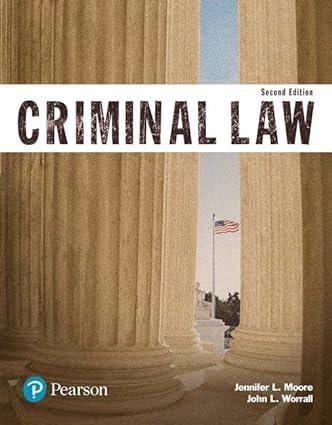Prisoners sentenced to death in the State of Oklahoma filed an action in federal court . .
Question:
Prisoners sentenced to death in the State of Oklahoma filed an action in federal court . . . contending that the method of execution now used by the State violates the Eighth Amendment because it creates an unacceptable risk of severe pain. They argue that midazolam, the first drug employed in the State’s current three-drug protocol, fails to render a person insensate to pain. After holding an evidentiary hearing, the District Court denied four prisoners’ application for a preliminary injunction, finding that they had failed to prove that midazolam is ineffective. The Court of Appeals for the Tenth Circuit affirmed and accepted the District Court’s finding of fact regarding midazolam’s efficacy For two independent reasons, we also affirm. First, the prisoners failed to identify a known and available alternative method of execution that entails a lesser risk of pain, a requirement of all Eighth Amendment method-of-execution claims. Second, the District Court did not commit clear error when it found that the prisoners failed to establish that Oklahoma’s use of a massive dose of midazolam in its execution protocol entails a substantial risk of severe pain.
*** While methods of execution have changed over the years, “[t]his Court has never invalidated a State’s chosen procedure for carrying out a sentence of death as the infliction of cruel and unusual punishment.” In Wilkerson v. Utah (1879), the Court upheld a sentence of death by firing squad. In, In re Kemmler the Court rejected a challenge to the use of the electric chair. And the Court did not retreat from that holding even when presented with a case in which a State’s initial attempt to execute a prisoner by electrocution was unsuccessful. Most recently, in Baze, seven Justices agreed that the three-drug protocol . . . does not violate the Eighth Amendment.
*** Our first ground for affirmance is based on petitioners’
failure to satisfy their burden of establishing that any risk of harm was substantial when compared to a known and available alternative method of execution. In their amended complaint, petitioners proffered that the State could use sodium thiopental as part of a single-drug protocol. They have since suggested that it might also be constitutional for Oklahoma to use pentobarbital. But the District Court found that both sodium thiopental and pentobarbital are now unavailable to Oklahoma’s Department of Corrections. The Court of Appeals affirmed that finding, and it is not clearly erroneous. On the contrary, the record shows that Oklahoma has been unable to procure those drugs despite a good-faith effort to do so.
Questions:
1. Explain the defendants’ legal argument in regard to their death sentences.
2. What test is the court applying in evaluating the defendants’ arguments?
3. Why did Justice Breyer and Justice Ginsburg dissent? Explain their position.
Step by Step Answer:






